A picture of health; Fish survey helps determine on going efforts to clean waterways
Published 8:57 am Wednesday, August 2, 2017
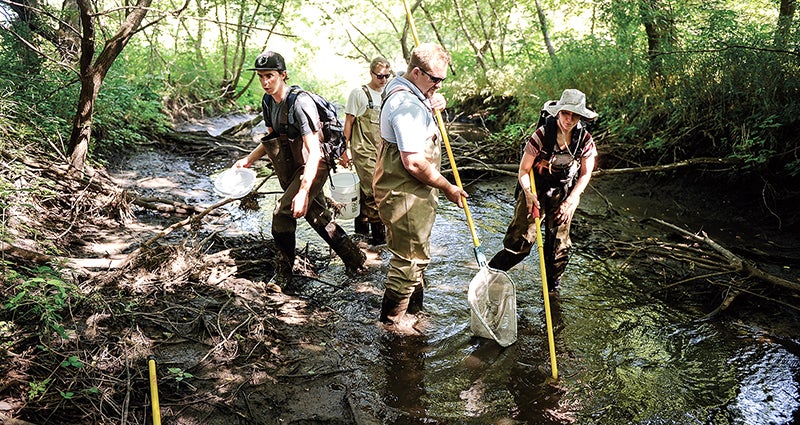
- University of Minnesota Stream Biologist Brenda DeZiel, from right, Cedar River Watershed District Watershed Technician James Fett, David Wick from the Conservation Core and University of Minnesota intern Mose McLain begin their walk up Dobbins Creek south of Brownsdale Tuesday afternoon. They were studying fish communities to determine the health of the creek. Photos by Eric Johnson/photodesk@austindailyherald.com
Cedar River Watershed Technician James Fett and University of Minnesota stream biologist Brenda DeZiel looked downstream to a narrow point in Dobbins Creek Tuesday morning, where water was running over a particularly shallow portion of the small stream that ran into a deeper hole next to a tree.
Both of them agreed that that was their next target. Trudging through the muck of the creek, DeZiel put the electo-fish unit wand into the water and began waving it back and forth as small fish began floating to the surface where Fett began scooping them up.
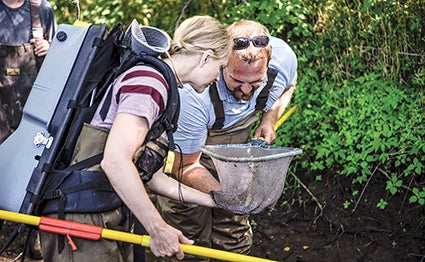
James Fett and Brenda DeZiel take a quick glance at some fish they collected Tuesday morning.
The unit, designed to send a small electrical current into the river, stuns the fish so they could be collected for the pair’s ultimate goal: determining the health of the stream as a whole.
“What we’re here doing today is looking at fish communities that live in the stream and these fish communities can tell us how healthy this stream is,” Fett said. “They can tell us a lot about how our practices are affecting the stream.”
A lot of effort has been put into studying Dobbins Creek over the years simply because of the layout of the creek itself. There is a high slope from the headwaters to where the creek empties into the Cedar River. This becomes a flashpoint for pollutants entering the stream.
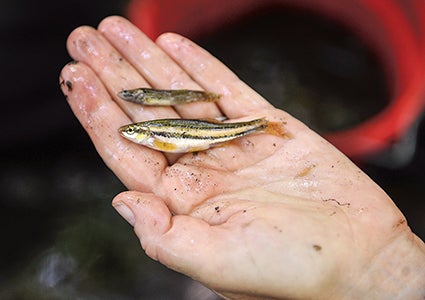
University of Minnesota Stream Biologist Brenda DeZiel holds a fantale darter and souther red-belly dace. The dace, the bigger of the two, is found in clearner water and can be an indication to a stream like Dobbins Creek becoming healthier.
“Over the years the Cedar River Watershed District has done a lot of studies in the whole district and Dobbins has popped up on several different studies and reports so it’s become a priority for us,” Fett said. “We’ve also seen high levels of pollutants in the past, so between the flashiness and the pollutants in the stream, and several reports and studies, we’ve decided to target the Dobbins.”
And that’s where the fish count comes in.
“I’m hoping to see a bunch of species of fish,” DeZiel said. “One of the special fish that I would like to see is the southern red-bellied dace. It’s got a very vibrant red stripe down the side. It’s very colorful but it’s the canary in the coal mine of water indicators because it likes clean water and course gravels. That would tell me that the habitat conditions are doing fairly well.”
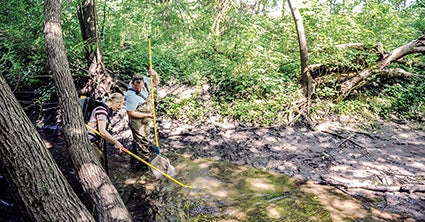
Brenda DeZiel and James Fett collect fish in Dobbins Creek using electroshock which stuns the fish momentarily.
During the search they did find the dace and eight other species in the small stretch of Dobbins.
“We ended up finding a lot of fish,” Fett said. “Definitely more fish than we’ve found since we started.”
In the past, fish have had problems spawning, a result of sediments brought in from runoffs.
An overabundance of sediment clogs the creek and smothers the rocks fish use to spawn on. But thanks to pointed projects launched by the Cedar Watershed District, DeZiel is seeing a comeback of sorts.
“Last year we noticed there was a difference in the number of species,” she said. “There seems to be less sediment in some locations so I don’t know if it’s flushing out or just part of the response.”
“This year I noticed, that I haven’t seen in the data before, is this year’s first-born fish that were spawned in the spring, they are very, very small so fish are using the headwaters and are having a successful reproduction.”
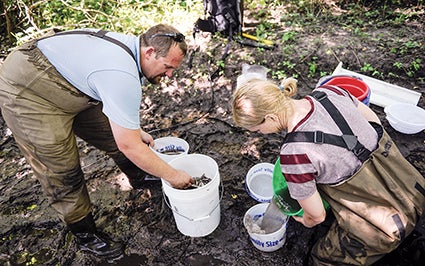
James Fett and Brenda DeZiel begin sorting through the fish they collected in Dobbins Creek Tuesday morning.
That’s a sign of optimism, at least on a local level in Mower County which has been getting a positive response from landowners willing to take part in conservation efforts, especially in the area of buffer strips, mandated by the state of Minnesota to help control and filter runoff from fields.
When the law was enacted in 2015, Mower County was already in 95 percent compliance. All of this effort for cleaner water has put the county ahead of the curve in Minnesota.
“I haven’t been around all over the state, but I have been in different watersheds,” DeZiel said. “When I was here in 2009, part of the MPCA’s monitoring and assessment year, I noticed the Cedar had a lot of natural springs that keep the water temperature cooler. I think some areas are doing pretty well with the fish communities compared to the areas in western Minnesota.”
It also carries some optimistic momentum into the future.
“I think in any of the land use practices, especially within the area, there seems to be a lot of interest to apply and as long as you have a lot of people interested in doing some more practices I think the cumulative effect is going to have some improvement,” DeZiel said.
Fett said this large-scale project is made possible due to three grants — targeted watershed demonstration grants through the Clean Water Fund, 319 grants through the Minnesota Pollution Control Agency Section 319 grant and capital improvement through the Hormel Foundation.



